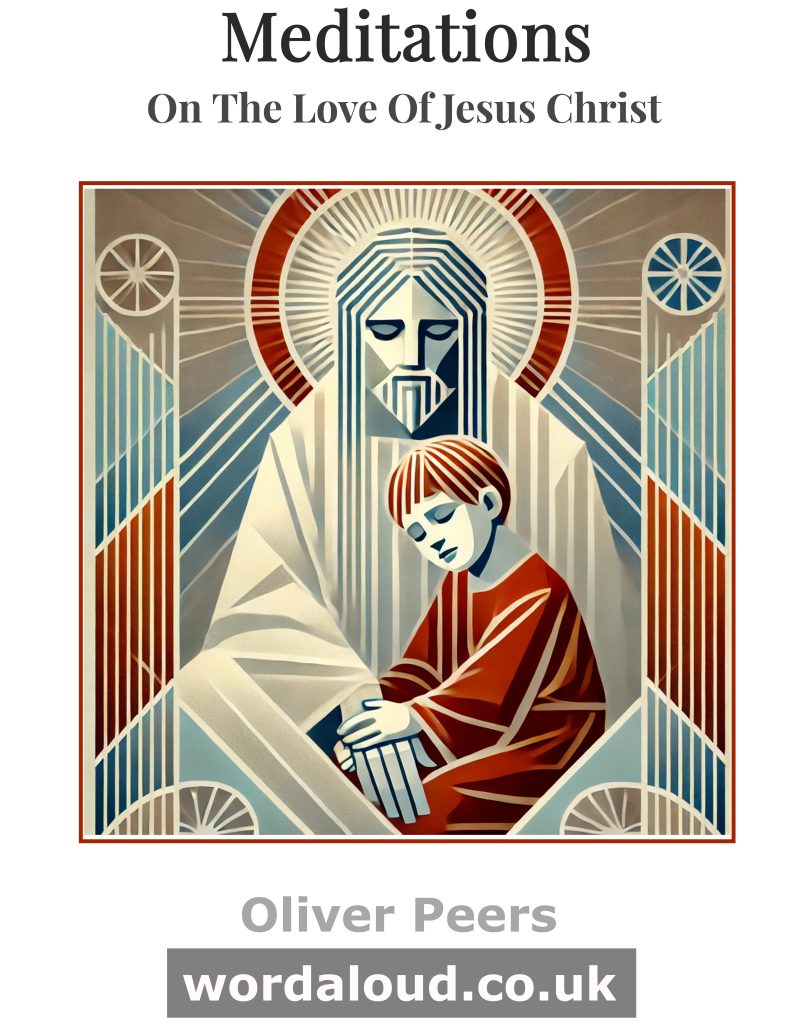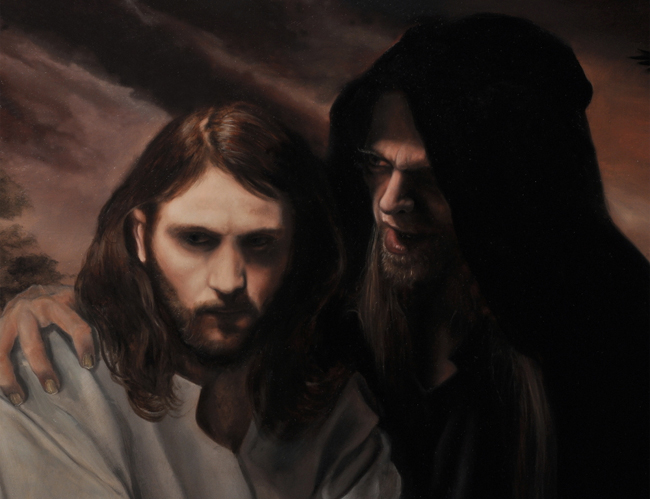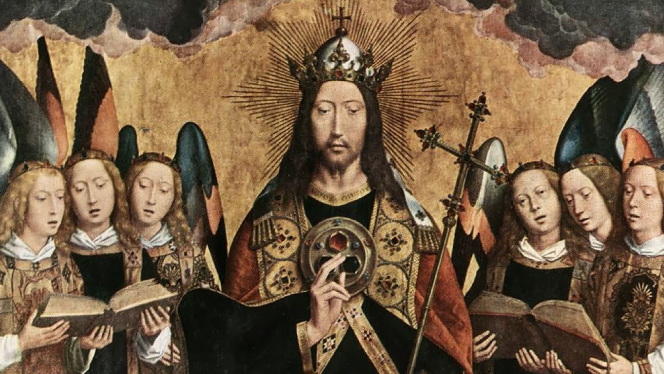Christian Art | Parousia | Second Coming | Lamb Of God, You Take Away The Sins Of The World
Luke 17: 26-37 (Audio Bible KJV, Spoken Word)
Early Christian thought about the Parousia – the second coming – was largely influenced by the teachings of Jesus and the writings of Saint Paul. In the early Christian community, expectation of Christ’s return was strong, and many Christians believed that it would happen in their lifetime. This belief is evident in the New Testament, where the authors express a sense of urgency in their writings and encourage their readers to be prepared for Christ’s imminent return.
As Christianity spread throughout the Roman Empire, the idea of the Parousia became more complex and nuanced. Theological debates arose around the nature of Christ’s return and the events that would precede it. Some theologians, such as Origen and Augustine, saw the Parousia as a spiritual event that was already happening in the Church. Others, such as the Montanists and the millenarians, believed in a literal, physical return of Christ and the establishment of a new, earthly Kingdom.
In the Middle Ages, the Parousia was often associated with apocalypticism and the idea of a final, cataclysmic battle between good and evil – the last battle. The idea of the Antichrist, who would precede Christ’s return, became a popular theme in Christian literature, and the book of Revelation (Apocalypse – meaning to reveal, to uncover) was interpreted as a prophetic guide to the end of the world.
Biblical Basis For The Parousia | The Second Coming
The concept of the Parousia, or the Second Coming of Jesus Christ, is central to Christian eschatology and is supported by numerous biblical passages in both the Old and New Testaments.
In the Old Testament, there are numerous passages that refer to the coming of a Messiah who will restore Israel and bring about the final judgment. For example, in Daniel 7:13-14, it is written: ‘I saw in the night visions, and, behold, one like the Son of man came with the clouds of heaven, and came to the Ancient of days, and they brought him near before him. And there was given him dominion, and glory, and a kingdom, that all people, nations, and languages, should serve him: his dominion is an everlasting dominion, which shall not pass away, and his kingdom that which shall not be destroyed.’ This passage describes a divine figure who comes in the clouds and is given dominion over all nations.
In the New Testament, the Parousia is described in greater detail, particularly in the teachings of Jesus and the writings of Saint Paul. Jesus speaks of his return in many passages, including Matthew 24:30-31, where Jesus says: ‘And then shall appear the sign of the Son of man in heaven: and then shall all the tribes of the earth mourn, and they shall see the Son of man coming in the clouds of heaven with power and great glory. And he shall send his angels with a great sound of a trumpet, and they shall gather together his elect from the four winds, from one end of heaven to the other.’ Here, Jesus describes his return in power and glory, accompanied by angels who gather Jesus’ elect from all over the world.
In Saint Paul’s letters, the Parousia is also described in detail. In 1 Thessalonians 4:16-17, Saint Paul writes: ‘For the Lord himself shall descend from heaven with a shout, with the voice of the archangel, and with the trump of God: and the dead in Christ shall rise first: Then we which are alive and remain shall be caught up together with them in the clouds, to meet the Lord in the air: and so shall we ever be with the Lord.’ This passage describes a resurrection of the dead and the gathering of believers to meet the Lord Jesus in the air.
The language and imagery used to describe the Parousia are often dramatic and apocalyptic in nature. The Parousia is often described as a time of judgment, when the righteous will be separated from the wicked, and God’s justice will be fully revealed. The imagery of clouds, trumpets, and angels is used to depict the power and glory of Christ’s return.
Theological Interpretations Of The Parousia | Jesus’ Second Coming
The concept of the Parousia has been interpreted in a variety of ways throughout Christian history.
- Dispensationalism
Dispensationalism is a theological framework that emerged in the 19th Century and has since become popular among some evangelical and fundamentalist Christians. Dispensationalists believe that history is divided into distinct periods or ‘dispensations’, each of which is marked by a particular mode of divine revelation and a specific plan of salvation. According to dispensationalist theology, the Parousia will be preceded by a period of tribulation, during which the Antichrist will establish a one-world government and the Jews will be restored to their homeland. The Parousia itself will involve a physical, visible return of Christ, who will establish a thousand-year reign on earth before the final judgment.
- Preterism
Preterism is a theological interpretation of the Parousia that holds that many of the prophecies in the New Testament, particularly those in the book of Revelation, were fulfilled in the first century AD. According to this view, the Parousia occurred in a spiritual sense when Christ ascended to heaven and sent the Holy Spirit to empower the Church. Preterists argue that the tribulation and other end-time events predicted in the New Testament were fulfilled in the destruction of the Temple in Jerusalem in AD 70.
- Postmillennialism
Postmillennialism is a theological view that holds that the Parousia will occur after a period of history in which the Church will gradually bring about the kingdom of God on earth. According to this view, the Church will spread the gospel throughout the world, and social, political, and economic conditions will gradually improve. Eventually, Christ will return to a world that has been largely transformed by the Gospel.
- Amillennialism
Amillennialism is a theological interpretation of the Parousia that holds that the thousand-year reign of Christ mentioned in the book of Revelation is a symbolic representation of the Church age. According to this view, the Parousia will occur at the end of history, after which there will be a final judgment and the establishment of a new heaven and a new earth.
- Liberation Theology
Liberation theology is a theological movement that emerged in the mid-20th Century and emphasizes the social and political implications of the gospel. According to liberation theology, the Parousia represents a radical transformation of society in which the oppressed and marginalized will be lifted up and the structures of oppression will be dismantled. Some liberation theologians see the Parousia as a call to social and political action, emphasizing the importance of solidarity with the poor and the marginalized.
Implications Of The Parousia For Christian Life
The doctrine of the Parousia has significant implications for Christian life and practice.
- Hope
The Parousia offers a source of hope for Christians, reminding them that this world is not the final destination and that the ultimate reality is the kingdom of God. This hope can sustain Christians in difficult times and inspire them to work for justice and peace in the world.
- Accountability
The belief in the Parousia also provides a sense of accountability for Christians, who are called to live in light of the coming judgment. This means living lives of holiness, justice, and compassion, and using the gifts and resources that God has given them to serve others.
- Urgency
The doctrine of the Parousia also brings a sense of urgency to Christian mission and evangelism, as Christians are called to share the Gospel and bring others into the Kingdom of God before the end of the age. This urgency can motivate Christians to be bold and creative in their outreach efforts, as we seek to bring the good news to people in diverse cultural and social contexts.
- Transformation
The Parousia also points to the ultimate transformation of all things, as God makes all things new and brings about the full realization of his kingdom. This transformation includes not only the physical creation but also the social, political, and economic structures of the world, as the Gospel challenges and transforms the powers and principalities that perpetuate injustice and oppression.
- Community
Finally, the doctrine of the Parousia underscores the importance of Christian community, as Christians are called to live in fellowship with one another and support each other in our shared mission. This community is a foretaste of the Kingdom of God, in which people from every tribe, language, and nation will come together in worship and service.
Sign Of The Times
One aspect of the Parousia that has received considerable attention in Christian theology is the signs that are said to precede it. These signs are described in various passages in the Bible, including Matthew 24, Mark 13, and Luke 21, and include wars and rumours of wars, natural disasters, false prophets, persecution, and the spread of the gospel.
In Matthew 24:6-8, Jesus tells his disciples: ‘You will hear of wars and rumours of wars. See that you are not alarmed, for this must take place, but the end is not yet. For nation will rise against nation, and kingdom against kingdom, and there will be famines and earthquakes in various places. All these are but the beginning of the birth pains.’ Similarly, in Mark 13:7-8, Jesus says: ‘And when you hear of wars and rumours of wars, do not be alarmed. This must take place, but the end is not yet. For nation will rise against nation, and kingdom against kingdom. There will be earthquakes in various places; there will be famines. These are but the beginning of the birth pains.’
These passages suggest that the signs of the times include not only wars and natural disasters but also false prophets and persecution. In Matthew 24:11, Jesus warns that ‘many false prophets will arise and lead many astray’. In verse 9, Jesus says: ‘Then they will deliver you up to tribulation and put you to death, and you will be hated by all nations for my name’s sake.’
The interpretation of these signs has varied throughout Christian history. Some interpreters have seen them as literal signs that will precede the Parousia, while others have understood them as symbolic descriptions of the general state of the world in the period leading up to the end of the age. Still others have seen the signs as having both literal and symbolic meaning, with the events described in the passages serving as both warnings of what is to come and representations of the ongoing struggle between good and evil in the world.
Regardless of their interpretation, the signs of the times have relevance for contemporary believers. They remind us that the world is not as it should be and that we live in a time of both great blessing and great challenge. The signs call us to be alert and prepared for the coming of the Lord Jesus, living lives of holiness and service in the midst of a world that is often marked by violence, injustice, and suffering.
The signs of the times also remind us of the importance of the Gospel, which Jesus describes in Matthew 24:14 as being preached ‘in the whole world as a testimony to all nations, and then the end will come’. This Gospel of the Kingdom, which announces the good news of God’s salvation and invites all people to repent and believe, is the key to understanding the signs of the times and the hope that we have in the Parousia.
Return Of The King | Christ And The Resurrection
The return of Christ and the resurrection of the dead are central aspects of the Christian doctrine of the Parousia. These events are described in various passages in the New Testament, including 1 Thessalonians 4:13-18 and 1 Corinthians 15:50-58.
In 1 Thessalonians 4:16-17, Saint Paul writes: ‘For the Lord himself will descend from heaven with a cry of command, with the voice of an archangel, and with the sound of the trumpet of God. And the dead in Christ will rise first. Then we who are alive, who are left, will be caught up together with them in the clouds to meet the Lord in the air, and so we will always be with the Lord.’ Similarly, in 1 Corinthians 15:52, Saint Paul says that ‘in a moment, in the twinkling of an eye, at the last trumpet. For the trumpet will sound, and the dead will be raised imperishable, and we shall be changed’.
These passages use vivid language and imagery to describe the return of Christ and the resurrection of the dead. The image of Christ descending from heaven with a cry of command, the voice of an archangel, and the sound of a trumpet emphasizes the grandeur and majesty of the event. The idea that the dead in Christ will rise first suggests that the resurrection will be a bodily, physical event that will involve the reanimation of the physical bodies of believers who have died. The image of believers being caught up in the clouds to meet the Lord in the air underscores the idea of the Parousia as a moment of reunion between Christ and his followers, a time of great joy and celebration.
Theological Implications Of The Second Coming
Theological implications of the return of Christ and the resurrection of the dead are significant. They emphasize the centrality of Christ in the Christian understanding of salvation and eternal life. As Saint Paul writes in 1 Corinthians 15:14: ‘If Christ has not been raised, then our preaching is in vain and your faith is in vain.’ The resurrection of Christ is the foundation of the Christian faith, and the resurrection of believers is seen as the ultimate fulfilment of the promise of salvation and eternal life that is offered through faith in Jesus.
The doctrine of the resurrection also has implications for Christian ethics and eschatology. It emphasizes the importance of living a life of faithfulness and obedience in the present, in light of the future hope that is promised in the Parousia. As Saint Paul writes in 1 Corinthians 15:58: ‘Therefore, my beloved brothers, be steadfast, immovable, always abounding in the work of the Lord, knowing that in the Lord your labor is not in vain.’ The knowledge of the coming resurrection and the return of Christ should inspire believers to live lives of love, justice, and service, seeking to bring the kingdom of God to bear on the world in the present.
Millennium
The concept of the millennium, or the thousand-year reign of Christ, has been a topic of debate and speculation in Christian theology for centuries. It is closely connected to the Parousia, as many believe that Christ’s return will inaugurate this period of peace and prosperity. However, there is much disagreement among Christians about the nature and timing of the millennium.
Premillennialism is the belief that Christ will return before the millennium, which will be a literal thousand-year period of peace and prosperity on Earth. This view is based on a literal interpretation of the Biblical passages that describe the millennium, such as Revelation 20:1-6. According to premillennialism, the events leading up to Christ’s return will be marked by widespread persecution of Christians, wars, and natural disasters. After Jesus returns, he will establish his kingdom on Earth and rule with his saints for a thousand years, during which time the devil will be bound and unable to deceive the nations. At the end of the millennium, Satan will be released and will gather an army to wage war against Christ, but he will be defeated and cast into the lake of fire along with all unbelievers.
Postmillennialism, on the other hand, is the belief that the millennium will be a period of spiritual prosperity on earth that will gradually lead to the triumph of the Gospel and the establishment of Christ’s kingdom. This view is based on a metaphorical interpretation of the biblical passages that describe the millennium, as well as the belief that the spread of the Gospel will bring about social and political change. According to postmillennialism, the events leading up to Christ’s return will be marked by the gradual spread of the Gospel and the transformation of society. After a long period of peace and prosperity, Christ will return to earth and usher in the final judgment.
Amillennialism is the belief that the millennium is a symbolic representation of the present age in which we live, rather than a literal thousand-year period. This view is based on the belief that the Kingdom of God is already present on Earth through the Church, and that Christ’s reign is spiritual rather than political. According to amillennialism, the events leading up to Christ’s return will be marked by the ongoing struggle between good and evil, and there will be no literal thousand-year period of peace and prosperity on earth. After Christ returns, he will judge the living and the dead and establish the new heaven and new Earth, in which the saints will dwell with him forever.
Theological implications of the millennium include the nature of Christ’s kingdom, the role of the church in society, and the relationship between faith and politics. Premillennialism emphasizes the political nature of Christ’s kingdom and the need for Christians to resist the world’s systems, while postmillennialism emphasizes the transformative power of the gospel in society and the role of Christians in bringing about social change. Amillennialism emphasizes the spiritual nature of Christ’s kingdom and the need for Christians to focus on their spiritual life and the proclamation of the gospel.
Last Judgement
The last judgment is a central concept in Christian theology, closely linked to the Parousia and the resurrection of the dead. According to Christian belief, the final judgment will take place at the end of the world, when Jesus returns in glory to judge the living and the dead.
Biblical passages such as Matthew 25:31-46, Acts 17:31, and Revelation 20:11-15 describe the last judgment in vivid detail. These passages portray a scene in which Jesus sits on a throne and separates the righteous from the wicked based on their deeds. The righteous are rewarded with eternal life in God’s presence, while the wicked are punished with eternal damnation.
The language and imagery used in these passages are often metaphorical and apocalyptic, emphasizing the cosmic significance of the final judgment. For example, in Matthew 25:31-46, Jesus is described as coming on the clouds of heaven with great power and glory, and the nations are gathered before him like sheep and goats.
The last judgment has significant theological implications for Christian beliefs about salvation and eternal life. It affirms that God’s justice will ultimately prevail and that there will be a reckoning for all human actions. It also underscores the importance of faith and good works, as these are the criteria by which people will be judged.
However, Christian views on the final judgment have varied throughout history. Some have emphasized the severity of God’s judgment and the eternal punishment of the wicked, while others have emphasized God’s mercy and the possibility of salvation even after death.
In recent times, some Christian theologians have also questioned the traditional doctrine of eternal damnation, arguing that it is inconsistent with the idea of a loving and merciful God. These theologians have proposed alternative views of the final judgment, such as universalism (the belief that all people will ultimately be saved) or annihilationism (the belief that the wicked will be destroyed rather than eternally punished).
Despite these differences, the final judgment remains a fundamental aspect of Christian eschatology, reminding believers of the ultimate accountability of all human beings before God.








